Enhancing the Biodiesel Production by Improving the Yield of Lipids in Wild Strain by Inducing Nitrogen Ion Mutation in Rhodotorula mucilaginosa
Abstract
1. Introduction
2. Materials and Methods
2.1. Isolation of Microbes
2.2. Ion Beam Radiation
2.3. Physical Mutation
2.4. Selection of Nitrogen Ion Mutated Strain
2.5. Determination of Mutation Rate
2.6. Molecular Sequence Analysis of Selected Strains
2.7. Culture and Growth Conditions of Wild and Nitrogen Ion Mutant Strain
2.8. Determination of Lipid and Biomass Yield
2.9. Extraction of Lipids from the Wild and Nitrogen Ion Mutant Strain
2.10. GCMS Analysis of Extracted Lipids
2.11. FTIR Analysis of Extracted Lipids
2.12. Transesterification
2.13. Properties of Biodiesel
3. Results
3.1. Screening of Maximum Lipid Production
3.2. Survival Rate of Nitrogen Mutated Strain
3.3. Molecular Identification of the Isolated Microorganism
3.4. Lipid and Biomass from the VS3 and MI-1 Strain
3.5. Fatty Acid Composition Analysis Using GCMS
3.6. Lipid Analysis Using FTIR
3.7. Biodiesel Properties from the VS3 and MI-1 Strain
4. Conclusions
Author Contributions
Funding
Data Availability Statement
Conflicts of Interest
References
- Arora, N.; Yen, H.W.; Philippidis, G.P. Harnessing the Power of Mutagenesis and Adaptive Laboratory Evolution for High Lipid Production by Oleaginous Microalgae and Yeasts. Sustainability 2002, 12, 5125. [Google Scholar] [CrossRef]
- Adewale, P.; Dumont, M.; Ngadi, M. Recent trends of biodiesel production from animal fat wastes and associated production techniques. Renew. Sustain. Energy Rev. 2015, 45, 574–588. [Google Scholar] [CrossRef]
- Khot, M.; Ghosh, D. Lipids of Rhodotorula mucilaginosa IIPL32 with biodiesel potential: Oil yield, fatty acid profile, fuel properties. J. Basic Microbiol. 2017, 57, 345–352. [Google Scholar] [CrossRef]
- Hu, W.; Li, W.; Chen, J. Recent advances of microbial breeding via heavy-ion mutagenesis at IMP. Lett. Appl. Microbiol. 2017, 65, 274–280. [Google Scholar] [CrossRef] [PubMed]
- Kuan, I.-C.; Kao, W.-C.; Chen, C.-L.; Yu, C.-Y. Microbial Biodiesel Production by Direct Transesterification of Rhodotorula glutinis Biomass. Energies 2018, 11, 1036. [Google Scholar] [CrossRef]
- Wahlen, B.D.; Morgan, M.R.; McCurdy, A.T.; Willis, R.M.; Morgan, M.D.; Dye, D.J.; Bugbee, B.; Wood, B.D.; Seefeldt, L.C. Biodiesel from Microalgae, Yeast, and Bacteria: Engine Performance and Exhaust Emissions. Energy Fuels 2013, 27, 220–228. [Google Scholar] [CrossRef]
- Gientka, I.; Gadaszewska, M.; Błażejak, S.; Kieliszek, M.; Bzducha-Wróbel, A.; Stasiak-Różańska, L.; Kot, A.M. Evaluation of lipid biosynthesis ability by Rhodotorula and Sporobolomyces strains in medium with glycerol. Eur. Food Res. Technol. 2017, 243, 275–286. [Google Scholar] [CrossRef]
- Tsai, S.-Y.; Yu, H.-T.; Lin, C.-P. The Potential of the Oil-Producing Oleaginous Yeast Rhodotorula mucilaginosa for Sustainable Production of Bio-Oil Energy. Processes 2002, 10, 336. [Google Scholar] [CrossRef]
- Kumar, R.R.; Rao, P.H.; Arumugam, M. Lipid extraction methods from microalgae: A comprehensive review. Front. Energy Res. 2015, 2, 61. [Google Scholar]
- Prabhu, A.A.; Gadela, R.; Bharali, B.; Deshavath, N.N.; Dasu, V.V. Development of high biomass and lipid yielding medium for newly isolated Rhodotorula mucilaginosa. Fuel 2019, 239, 874–885. [Google Scholar] [CrossRef]
- Breil, C.; Abert Vian, M.; Zemb, T.; Kunz, W.; Chemat, F. “Bligh and Dyer” and Folch Methods for Solid–Liquid–Liquid Extraction of Lipids from Microorganisms. Comprehension of Solvatation Mechanisms and towards Substitution with Alternative Solvents. Int. J. Mol. Sci. 2017, 18, 708. [Google Scholar] [CrossRef]
- Nojima, D.; Ishizuka, Y.; Muto, M.; Ujiro, A.; Kodama, F.; Yoshino, T.; Maeda, Y.; Matsunaga, T.; Tanaka, T. Enhancement of Biomass and Lipid Productivities of Water Surface-Floating Microalgae by Chemical Mutagenesis. Mar. Drugs 2017, 15, 151. [Google Scholar] [CrossRef] [PubMed]
- Al-Saedi, R.K.M.; Najem, A.M.; Abed, İ.J. Impact of the Chemical Mutagenesis on Biomass and Productivity of some Micro Green Algae. Eurasia Proc. Sci. Technol. Eng. Math. 2019, 6, 88–95. [Google Scholar]
- Bessadok, B.; Santulli, A.; Brück, T.; Sadok, S. Species disparity response to mutagenesis of marine yeasts for the potential production of biodiesel. Biotechnol. Biofuels 2019, 12, 129. [Google Scholar] [CrossRef] [PubMed]
- Huang, G.-H.; Chen, G.; Chen, F. Rapid screening method for lipid production in alga based on Nile red fluorescence. Biomass Bioenergy 2009, 33, 1386–1392. [Google Scholar] [CrossRef]
- Dong, T.; Knoshaug, E.P.; Pienkos, P.T.; Laurens, L.M. Laurens. Lipid recovery from wet oleaginous microbial biomass for biofuel production: A critical review. Appl. Energy 2016, 177, 879–895. [Google Scholar] [CrossRef]
- Patel, A.; Karageorgou, D.; Rova, E.; Katapodis, P.; Rova, U.; Christakopoulos, P.; Matsakas, L. An Overview of Potential Oleaginous Microorganisms and Their Role in Biodiesel and Omega-3 Fatty Acid-Based Industries. Microorganisms 2020, 8, 434. [Google Scholar] [CrossRef]
- Claeys, C.; Simoen, E. Radiation Effects in Advanced Semiconductor Materials and Devices; Springer Science & Business Media: Berlin/Heidelberg, Germany, 2002. [Google Scholar]
- Lemmer, K.C.; Zhang, W.; Langer, S.J.; Dohnalkova, A.C.; Hu, D.; Lemke, R.A.; Piotrowski, J.S.; Orr, G.; Noguera, D.R.; Donohue, T.J. Mutations That Alter the Bacterial Cell Envelope Increase Lipid Production. mBio 2017, 8, e00513-17. [Google Scholar] [CrossRef]
- Najafi MB, H.; Pezeshki, P. Bacterial mutation; types, mechanisms and mutant detection methods: A review. Eur. Sci. J. 2013, 4, 1857–7881. [Google Scholar]
- Halim, R.; Webley, P.A. Nile Red Staining for Oil Determination in Microalgal Cells: A New Insight through Statistical Modelling. Int. J. Chem. Eng. 2015, 2015, 695061. [Google Scholar] [CrossRef]
- Gohain, M.; Bardhan, P.; Laskar, K.; Sarmah, S.; Mandal, M.; Bora, U.; Kalita, M.C.; Goud, V.V.; Deka, D. Rhodotorula mucilaginosa: A source of heterogeneous catalyst for biodiesel production from yeast single cell oil and waste cooking oil. Renew. Energy 2020, 160, 220–230. [Google Scholar] [CrossRef]
- Cheirsilp, B.; Kitcha, S.; Torpee, S. Co-culture of an oleaginous yeast Rhodotorula glutinis and a microalga Chlorella vulgaris for biomass and lipid production using pure and crude glycerol as a sole carbon source. Ann. Microbiol. 2012, 62, 987–993. [Google Scholar] [CrossRef]
- Papanikolaou, S.; Aggelis, G. Biotechnological valorisation of biodiesel derived glycerol waste through production of single cell oil and citric acid by Yarrowia lipolytica. Lipid Technol. 2009, 21, 83–87. [Google Scholar] [CrossRef]
- Saenge, C.; Cheirsilp, B.; Suksaroge, T.T.; Bourtoom, T. Potential use of oleaginous red yeast Rhodotorula glutinis for the bioconversion of crude glycerol from biodiesel plant to lipids and carotenoids. Process Biochem. 2010, 46, 210–218. [Google Scholar] [CrossRef]
- Li, M.; Liu, G.L.; Chi, Z.; Chi, Z.M. Single cell oil production from hydrolysate of cassava starch by marine-derived yeast Rhodotorula mucilaginosa TJY15a. Biomass Bioenergy 2010, 34, 101–107. [Google Scholar] [CrossRef]
- Jagadesan, P.; Rajan, S.P.; Chauhan, A.S.; Narayana, C.S.; Vijayalakshmi, S.; Ranjitha, J. Physicochemical Analysis, Elicitation and Charaterisation of Bio-oil from Aloe barbadensis. IOP Conf. Ser. Mater. Sci. Eng. 2020, 923, 012076. [Google Scholar] [CrossRef]
- Chatzifragkou, A.; Makri, A.; Belka, A.; Bellou, S.; Mavrou, M.; Mastoridou, M.; Mystrioti, P.; Onjaro, G.; Aggelis, G.; Papanikolaou, S. Biotechnological conversions of biodiesel derived waste glycerol by yeast and fungal species. Energy 2011, 36, 1097–1108. [Google Scholar] [CrossRef]
- Cao, Y.; Yao, J.; Li, J.; Chen, X.; Wu, J. Breeding of high lipid producing strain of Geotrichum robustum by ion beam implantation. Electron. J. Biotechnol. 2010, 13, 2–3. [Google Scholar] [CrossRef]
- Shichang, L.; Pengpeng, Z.; Shaobin, G.; Hongxia, L.; Ya, L.; Shengnan, L. Screening of lipid high producing mutant from rhodotorula glutinis by low ion implantation and study on optimization of fermentation medium. Indian J. Microbiol. 2013, 53, 343–351. [Google Scholar] [CrossRef][Green Version]
- Kanakdande, A.P.; Khobragade, C.N.; Mane, R.S. Ultraviolet induced random mutagenesis in Bacillus amyloliquefaciens (MF 510169) for improving biodiesel production. Fuel 2021, 304, 121380. [Google Scholar] [CrossRef]
- Shinzawa-Itoh, K.; Hatanaka, M.; Fujita, K.; Yano, N.; Ogasawara, Y.; Iwata, J.; Yamashita, E.; Tsukihara, T.; Yoshikawa, S.; Muramoto, K. The 1.3-Å resolution structure of bovine cytochrome c oxidase suggests a dimerization mechanism. BBA Adv. 2021, 1, 100009. [Google Scholar] [CrossRef]
- Sallet, D.; Souza, P.O.; Fischer, L.T.; Ugalde, G.; Zabot, G.L.; Mazutti, M.A.; Kuhn, R.C. Ultrasound-assisted extraction of lipids from Mortierella isabelline. J. Food Eng. 2019, 242, 1–7. [Google Scholar] [CrossRef]
- Mubarak, M.; Shaija, A.; Suchithra, T.V. Experimental evaluation of Salvinia molesta oil biodiesel/diesel blends fuel on combustion, performance and emission analysis of diesel engine. Fuel 2021, 287, 119526. [Google Scholar] [CrossRef]
- Kumar, A.K. UV mutagenesis treatment for improved production of endoglucanase and β-glucosidase from newly isolated thermotolerant actinomycetes, Streptomyces griseoaurantiacus. Bioresour. Bioprocess. 2015, 2, 22. [Google Scholar] [CrossRef]
- Tensingh, J.A.S.; Shankar, V. Sustainable Production of Biodiesel Using UV Mutagenesis as a Strategy to Enhance the Lipid Productivity in R. mucilaginosa. Sustainability 2022, 14, 9079. [Google Scholar] [CrossRef]
- Hoekman, S.K.; Broch, A.; Robbins, C.; Ceniceros, E.; Natarajan, M. Review of biodiesel composition, properties, and specifications. Renew. Sustain. Energy Rev. 2012, 16, 143–169. [Google Scholar] [CrossRef]
- Ragit, S.S.; Mohapatra, S.K.; Gill, P.; Kundu, K. Brown hemp methyl ester: Transesterification process and evaluation of fuel properties. Biomass Bioenergy 2012, 41, 14–20. [Google Scholar] [CrossRef]
- Murugesan, A.; Subramaniam, D.; Avinash, A.; Nedunchezhian, N. Quantitative and qualitative analysis of biodiesel—An in-depth study. Int. J. Ambient. Energy 2013, 36, 19–30. [Google Scholar] [CrossRef]
- Liu, J.; Mukherjee, J.; Hawkes, J.J.; Wilkinson, S.J. Optimization of lipid production for algal biodiesel in nitrogen stressed cells of Dunaliella salina using FTIR analysis. J. Chem. Technol. Biotechnol. 2013, 88, 1807–1814. [Google Scholar] [CrossRef]

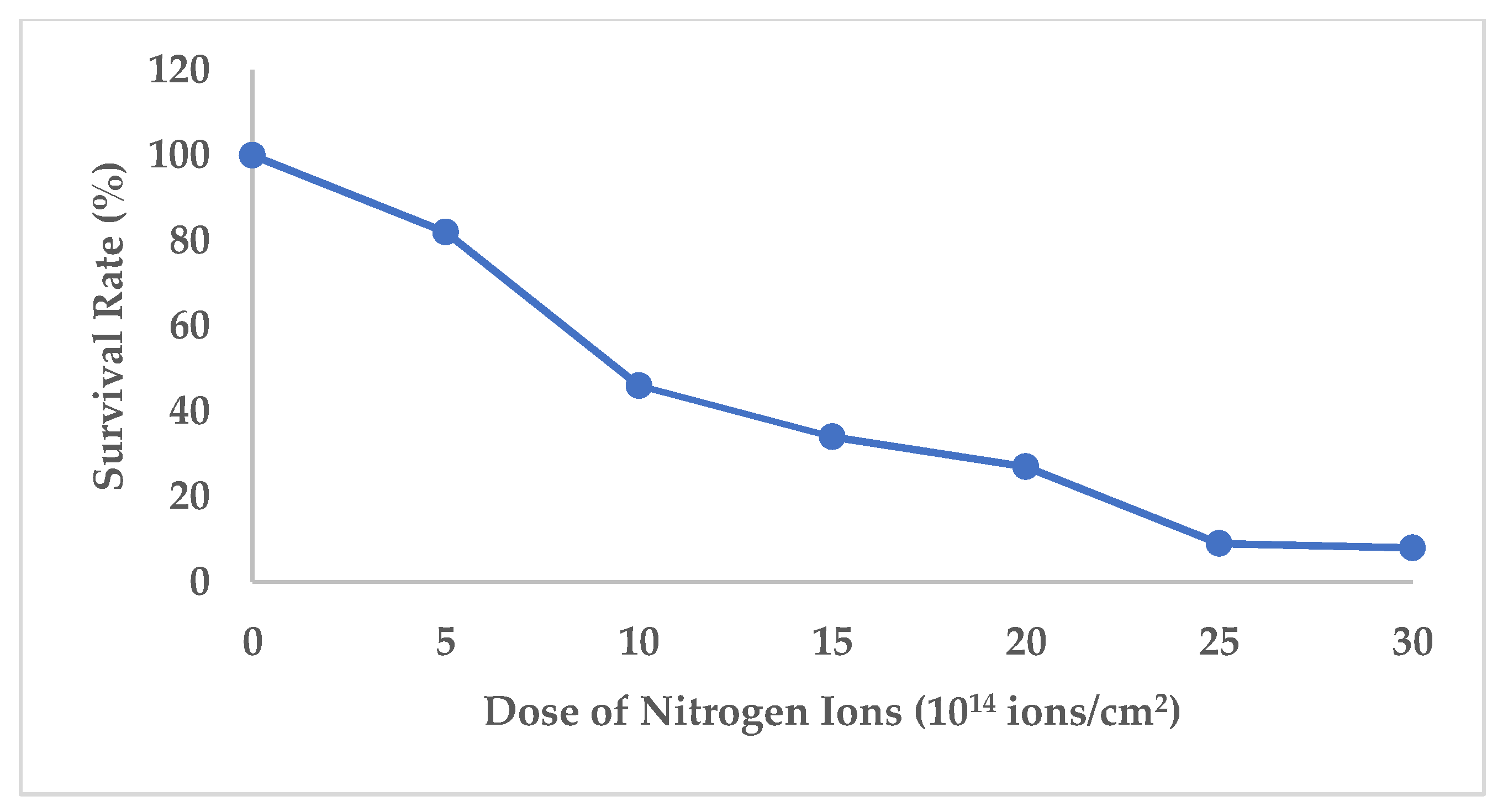
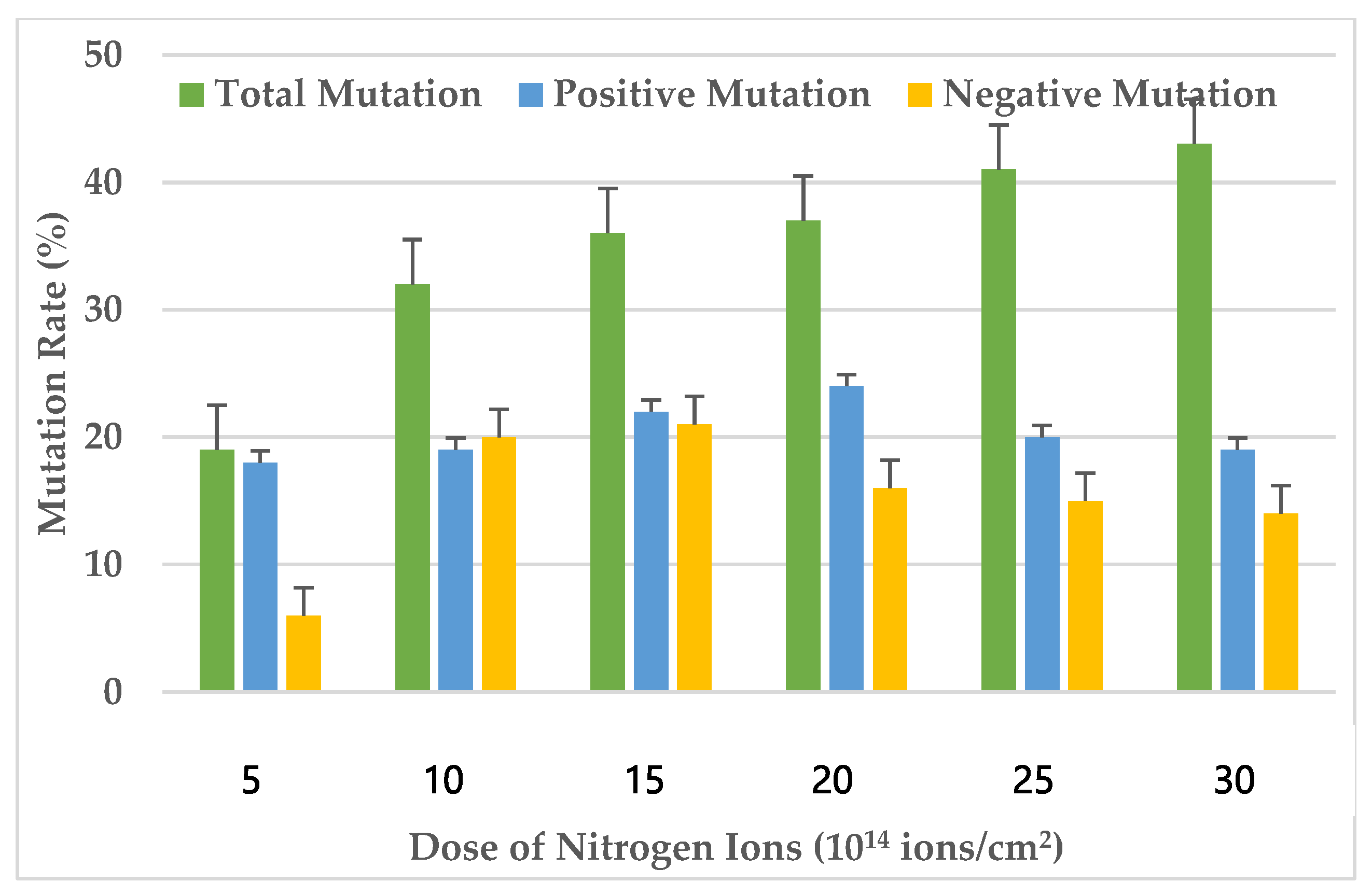

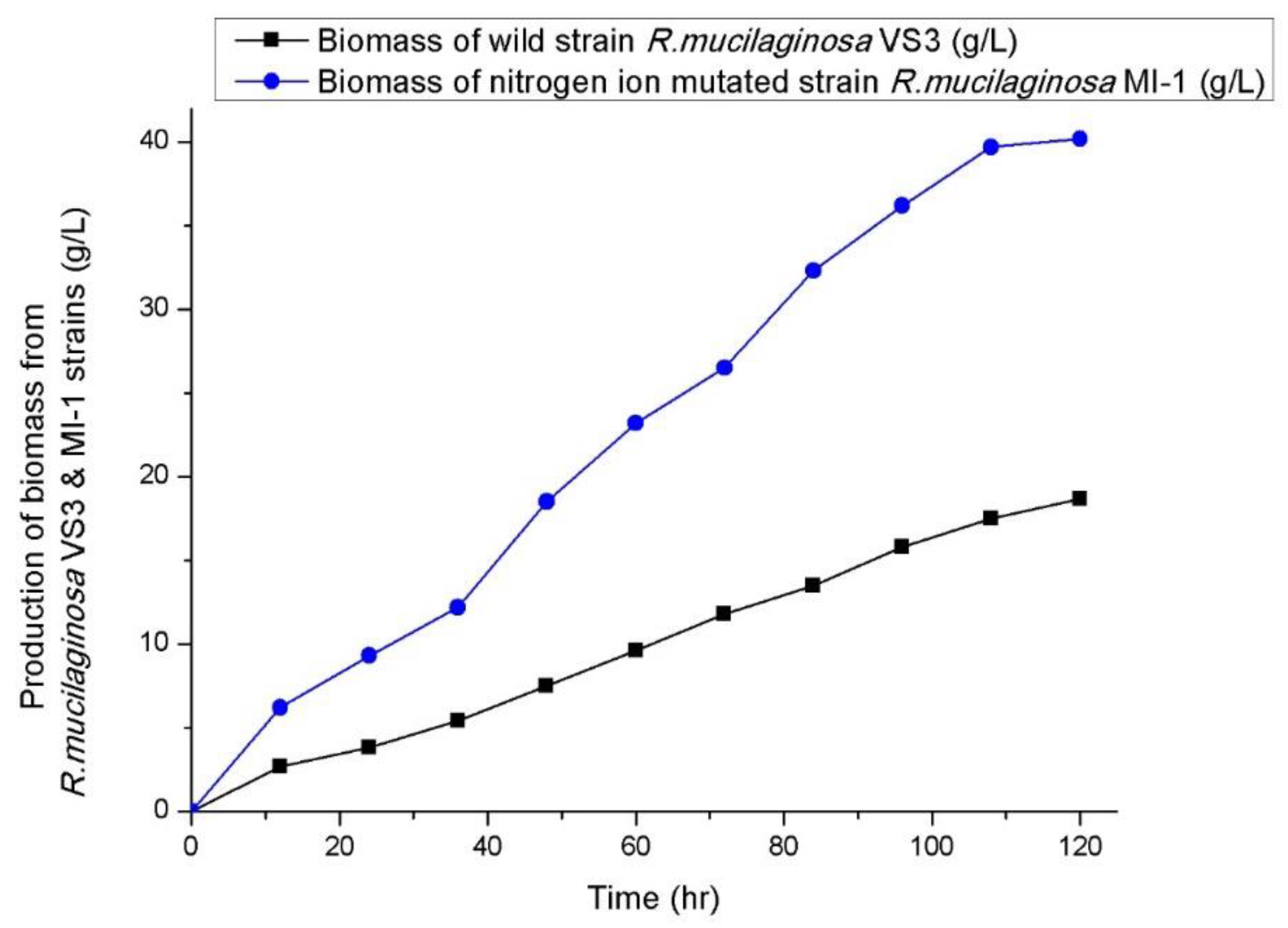
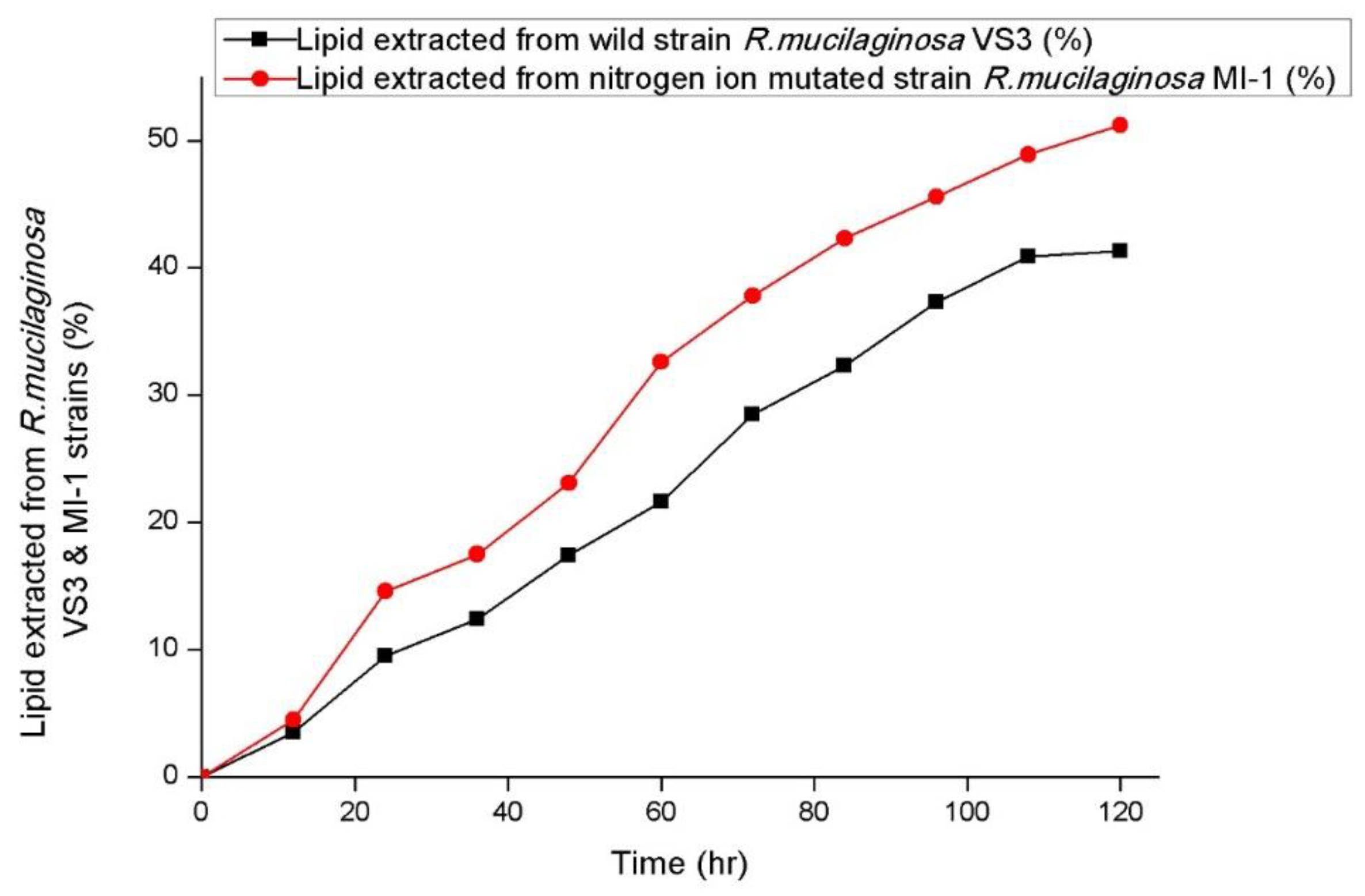

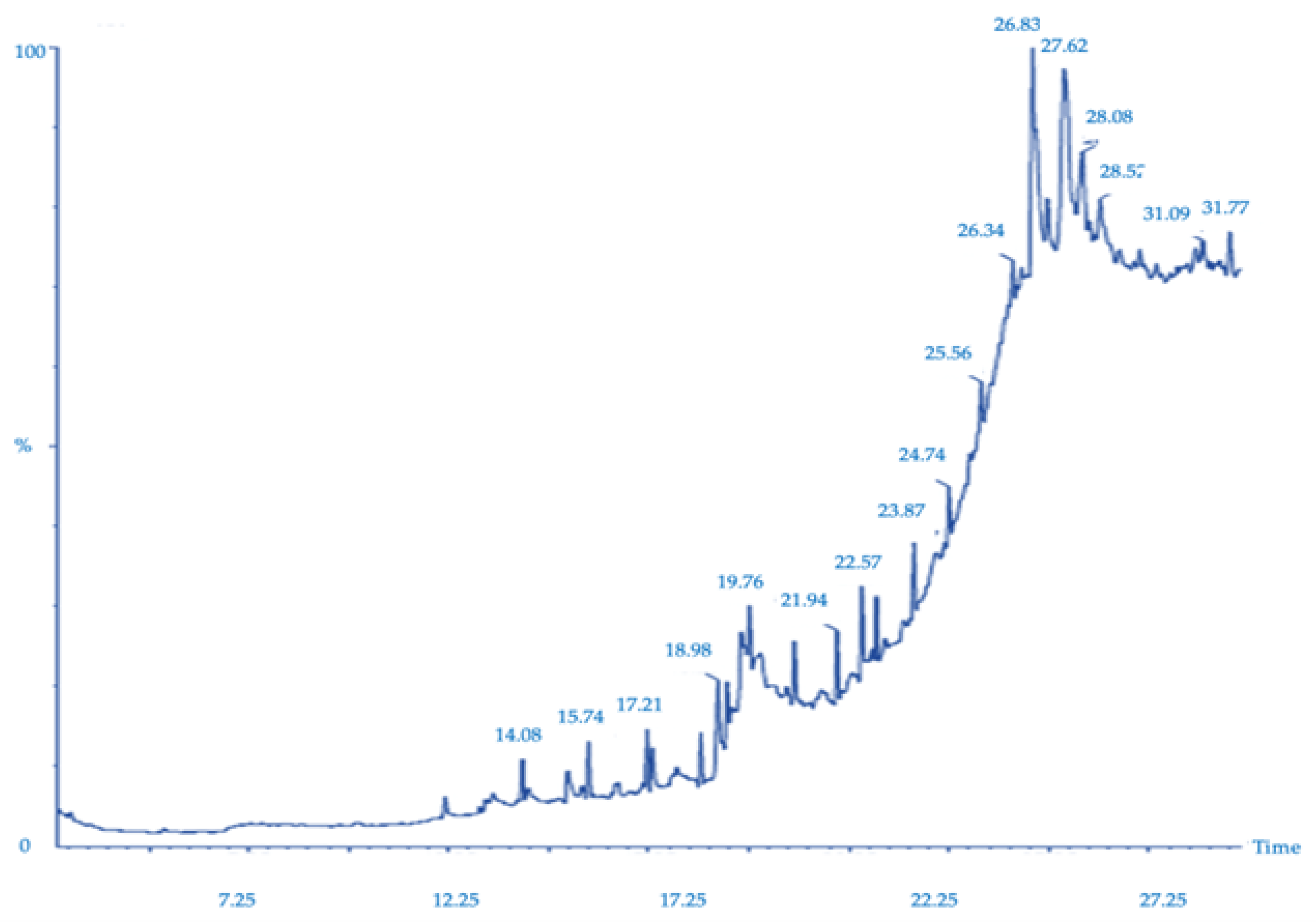
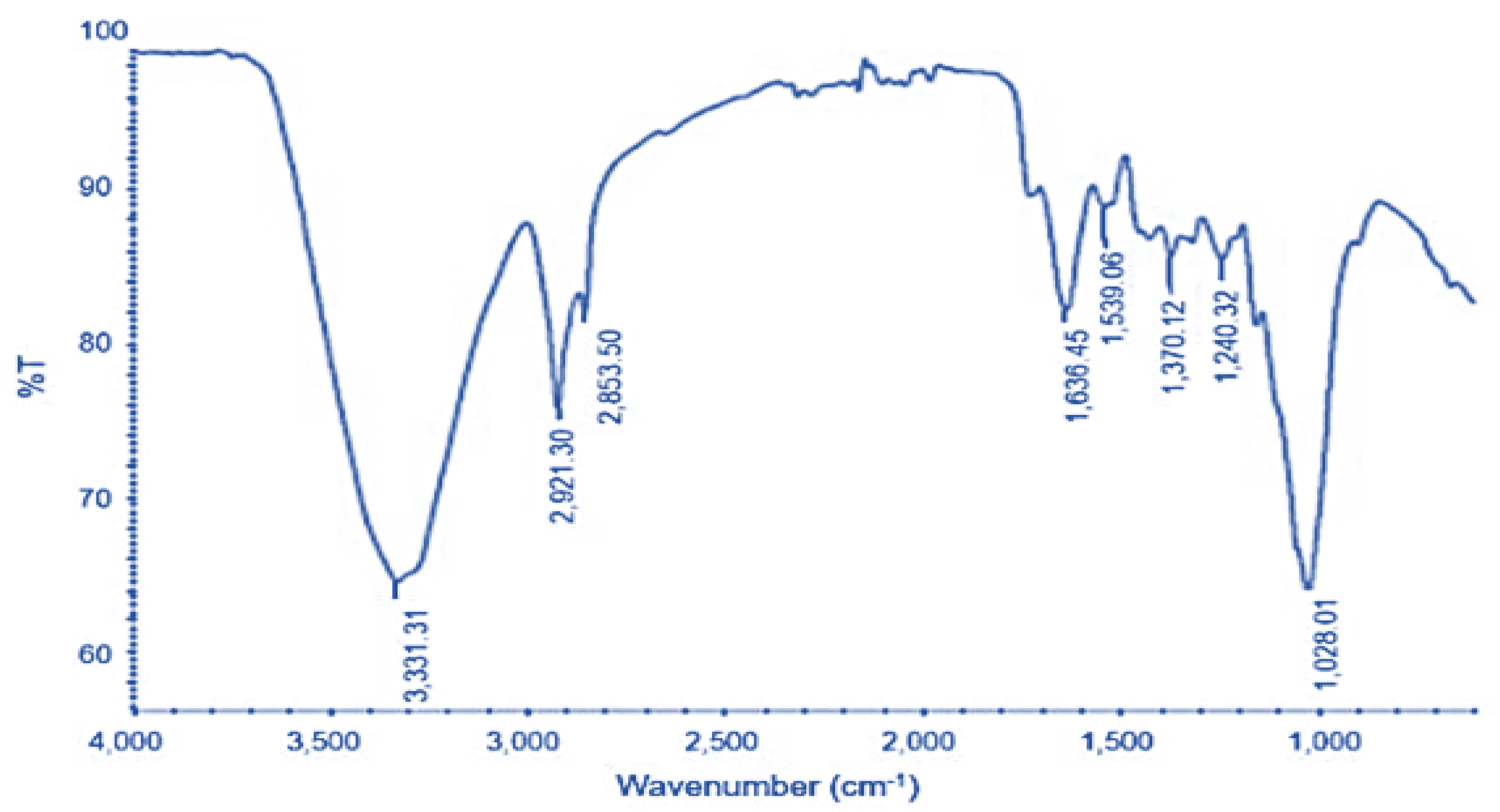

| Strain | Lipid Concentration (g/L) | Strain | Lipid Concentration (g/L) |
|---|---|---|---|
| SB1 | 0.27 ± 0.22 | SF1 | 0.26 ± 0.37 |
| SB2 | 0.58 ± 0.14 | SF2 | 0.35 ± 0.15 |
| SB3 | 0.05 ± 0.26 | SF3 | 0.12 ± 0.42 |
| SB4 | 0.38 ± 0.32 | SF4 | 0.15 ± 0.39 |
| SB5 | 0.26 ± 0.19 | SF5 | 0.13 ± 0.26 |
| SB6 | 0.15 ± 0.16 | SF6 | 0.23 ± 0.32 |
| SB7 | 0.08 ± 0.21 | SF7 | 0.14 ± 0.41 |
| SB8 | 0.20 ± 0.5 | SF8 | 0.14 ± 0.24 |
| SB9 | 0.13 ± 0.35 | SF9 | 0.3 ± 0.31 |
| SB10 | 0.14 ± 0.17 | SF10 | 0.13 ± 0.27 |
| S.No | Time (h) | Biomass of Wild Strain R. mucilaginosa VS3 (g/L) | Biomass of Nitrogen Ion Mutated Strain R. mucilaginosa MI-1 (g/L) |
|---|---|---|---|
| 1 | 0 | 0 | 0 |
| 2 | 12 | 2.7 ± 0.3 | 6.2 ± 0.7 |
| 3 | 24 | 3.8 ± 1.1 | 9.3 ± 0.1 |
| 4 | 36 | 5.4 ± 0.9 | 12.2 ± 1.9 |
| 5 | 48 | 7.5 ± 0.6 | 18.5 ± 2.1 |
| 6 | 60 | 9.6 ± 1.8 | 23.2 ± 1.4 |
| 7 | 72 | 11.8 ± 1.9 | 26.5 ± 0.8 |
| 8 | 84 | 13.5 ± 0.5 | 32.3 ± 0.4 |
| 9 | 96 | 15.8 ± 1.2 | 36.2 ± 1.5 |
| 10 | 108 | 17.5 ± 0.8 | 39.7 ± 1.7 |
| 11 | 120 | 18.7 ± 1.6 | 40.2 ± 0.4 |
| S.No | Time (h) | Lipid Extracted from Strain R. mucilaginosa VS3 (%) | Lipid Extracted from Nitrogen Ion Mutated Strain R. mucilaginosa MI-1 (%) |
|---|---|---|---|
| 1 | 0 | 0 | 0 |
| 2 | 12 | 3.5 ± 0.5 | 4.5 ± 1.4 |
| 3 | 24 | 9.5 ± 1.4 | 14.6 ± 1.9 |
| 4 | 36 | 12.4 ± 0.26 | 17.5 ± 0.7 |
| 5 | 48 | 17.4 ± 1.8 | 23.1 ± 0.3 |
| 6 | 60 | 21.6 ± 0.7 | 32.6 ± 1.1 |
| 7 | 72 | 28.5 ± 1.1 | 37.8 ± 0.9 |
| 8 | 84 | 32.5 ± 0.9 | 42.3 ± 1.3 |
| 9 | 96 | 37.3 ± 1.6 | 45.6 ± 0.5 |
| 10 | 108 | 40.9 ± 0.7 | 48.9 ± 1.7 |
| 11 | 120 | 41.3 ± 0.8 | 51.2 ± 0.8 |
| S.No | Number of Subculture | Lipid Content (%) from Mutant Strain |
|---|---|---|
| 1 | 6 | 62.3 |
| 2 | 12 | 62.1 |
| 3 | 18 | 61.8 |
| 4 | 24 | 61.8 |
| 5 | 30 | 61.7 |
| Peak No. | Compound Name | RT (Min) | Fatty Acid (%) | ||
|---|---|---|---|---|---|
| VS3 | MI-1 | R. mucilaginosa VS3 | R. mucilaginosa MI-1 | ||
| 1 | Tetradecanoic acid | 17.58 | 17.21 | 5.07 | 9.57 |
| 2 | Pentadecanoic acid | 19.29 | 18.98 | 9.24 | 11.05 |
| 3 | n-hexadecanoic acid | 19.49 | 19.76 | 11.24 | 12.36 |
| 4 | hexadecanoic acid | 22.66 | 21.94 | 6.85 | 8.17 |
| 5 | 9-octadecanoic acid | - | 25.56 | - | 11.22 |
| 6 | 9-octadecanoic acid (Z) hexyl ester | - | 26.83 | - | 5.23 |
| S.No | Properties | Units | Indian Standard | American Standard | Biodiesel | Test Procedure | |
|---|---|---|---|---|---|---|---|
| VS3 | MI-1 | ||||||
| 1 | Density | kg/m3 | 860–900 | 860 | 867 | ASTM D4052-91 | |
| 2 | Specific gravity | 0.86 | 0.87 | ||||
| 3 | Kinematic viscosity | mm2/s | 2.5–6.0 | 1.9–6.0 | 5.2 | 5.3 | ASTM D445 |
| 4 | Flash point | °C | 120 | 150 | 160 | 157 | ASTM D93 |
| 5 | Fire point | °C | 130 | 160 | 165 | 169 | ASTM D93 |
| 6 | Pour point | °C | −2 to 8 | −2 to 7 | ASTM D2500 | ||
| 7 | Calorific value | kJ/kg | 38,500 | - | 37,500 | 37,450 | Demirbas, 2008 |
| 8 | Acid value | Mg/KOH | 0.50 max | 0.80 max | 0.1 | 0.2 | FFA Titration |
| 9 | Cetane number | 51 min | 47 min | 56 min | 57 min | Krisnangkura, 1986 | |
Disclaimer/Publisher’s Note: The statements, opinions and data contained in all publications are solely those of the individual author(s) and contributor(s) and not of MDPI and/or the editor(s). MDPI and/or the editor(s) disclaim responsibility for any injury to people or property resulting from any ideas, methods, instructions or products referred to in the content. |
© 2023 by the authors. Licensee MDPI, Basel, Switzerland. This article is an open access article distributed under the terms and conditions of the Creative Commons Attribution (CC BY) license (https://creativecommons.org/licenses/by/4.0/).
Share and Cite
Sundarsingh Tensingh, J.A.; Shankar, V. Enhancing the Biodiesel Production by Improving the Yield of Lipids in Wild Strain by Inducing Nitrogen Ion Mutation in Rhodotorula mucilaginosa. Microbiol. Res. 2023, 14, 1413-1426. https://doi.org/10.3390/microbiolres14030096
Sundarsingh Tensingh JA, Shankar V. Enhancing the Biodiesel Production by Improving the Yield of Lipids in Wild Strain by Inducing Nitrogen Ion Mutation in Rhodotorula mucilaginosa. Microbiology Research. 2023; 14(3):1413-1426. https://doi.org/10.3390/microbiolres14030096
Chicago/Turabian StyleSundarsingh Tensingh, Joseph Antony, and Vijayalakshmi Shankar. 2023. "Enhancing the Biodiesel Production by Improving the Yield of Lipids in Wild Strain by Inducing Nitrogen Ion Mutation in Rhodotorula mucilaginosa" Microbiology Research 14, no. 3: 1413-1426. https://doi.org/10.3390/microbiolres14030096
APA StyleSundarsingh Tensingh, J. A., & Shankar, V. (2023). Enhancing the Biodiesel Production by Improving the Yield of Lipids in Wild Strain by Inducing Nitrogen Ion Mutation in Rhodotorula mucilaginosa. Microbiology Research, 14(3), 1413-1426. https://doi.org/10.3390/microbiolres14030096





